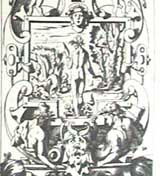
René Boyvin (1525-1580), Ornamental Panels of Pagan Gods, from Art Serve
Renaissance

|
René Boyvin (1525-1580), Ornamental Panels of Pagan Gods, from Art Serve |
Loosely defined, the Renaissance refers to the sixteenth century in Anjou, a period of great energy and turmoil that saw the rise of the modern nation of France and the emergence of a distinct style of arts and letters. We can identify several distinct phases:
First is the "renaissance" proper, that is, the "rebirth" of arts and letters in imitation of classical style. The humanist approach emphasized rhetoric and history, steeped in the love of the ancients. In Angers, a humanist circle developed around Jehan de Bourdigné, a canon of Saint-Laud and historian, and his younger brother, the poet Charles. Joachim du Bellay (1522-1560) joined the Pleïade in developing French as a literary language, particularly in his 1549 treatise Défense et illustration de la langue français. But it is in his book of poems Regrets that we find his nostalgia for his natal Anjou, and what he called "le douceur angévine.".

As classical Romans retired to their country villas for pleasure and meditation, so too did the French nobility leave Paris for their estates along the Loire. While formerly the royal residences were defensive "castles", Renaissance chateaux are elegant country homes, situated in open landscapes conducive to hunting, wine-making and other pastoral pleasures. In keeping with a new emphasis on secular life, the important buildings of this period are not usually ecclesiastical, but civic architecture. In Angers, consider the Hôtels de Pincé by architect Jean de Lespine. Artist and an engraver René Boyvin.
See more about Chateaux of the Loire.
Occupying a unique place is François Rabelais, a monk turned doctor, who produced the amazing five books La Vie de Gargantua et de Pantagruel, a "history of giants that is a chaos wherein are found learning, eloquence, coarse humor, and extravagances." Although Rabelais' joie de vivre is undeniable, his satiric approach to all matters of religion and politics exemplifies the critical spirit of this age. Scholars still debate whether he died faithful to his Catholicism, or a protesting atheist. This brief study guide to Gargantua should help get us started on his writing that can be as difficult as it is stimulating.
In 1517, when Martin Luther nailed his 95 suggestions for church reform on the door in Wittenburg, a protestant movement began that could not be contained. As was the case with other European nations, the government of France was tightly interwoven with the Catholic church, such that they could pray for une foi, une loi, un roi, or one faith, one law, one king. When religious practice was severely criticized by French protestants, known as Huguenots, theological questions became political. Civil authorities were asked to repress religious heresy; individuals forced to struggle for their right to worship also needed to fight for other political freedoms. These Wars of Religion tore the nation apart, most particularly after Calvinism arrived in France and Angers ca. 1555. Inquisition, protest, brutal reprisals and open warfare characterized the period until finally Henri de Navarre, himself a Protestant, succeeded in winning the throne in 1589. He converted to Catholicism, saying famously that "Paris was worth a mass", but also issued the Edict of Nantes in 1598, allowing freedom of worship. There were strong Huguenot communities in Angers and Baugé, but it was Saumur that became the Athens of protestantism," according to Voltaire. This state of affairs lasted until 1685, when the Edict of Nantes was repealed.
Read more about Huguenots in Anjou
There was also a movement for reform and change that stayed within the Catholic church. Humanists had been producing scholarly analysis of religious texts, calling for a rational theology and the end of corrupt clerics, simony, and superstitious worship of numerous saints. The Ecumenical Council of Trent (1545-1563) adopted many changes in church governance and worship that were noticeable throughout the Catholic realms. All churches were required to follow the Roman rite, getting rid of distinctive local liturgies. In a desire to bring the people together during Communion, church interiors were remodelled. In contrast to Protestant objections to idolatry, Catholics emphasized religious art, ushering in the period of art we call baroque, emphasizing drama, emotion, and religious authority.
Read more about the counter-reformation in Anjou.
| |
This page was meant to be viewed in frames. |
 Return to Return toAmelia Carr's Home Page |